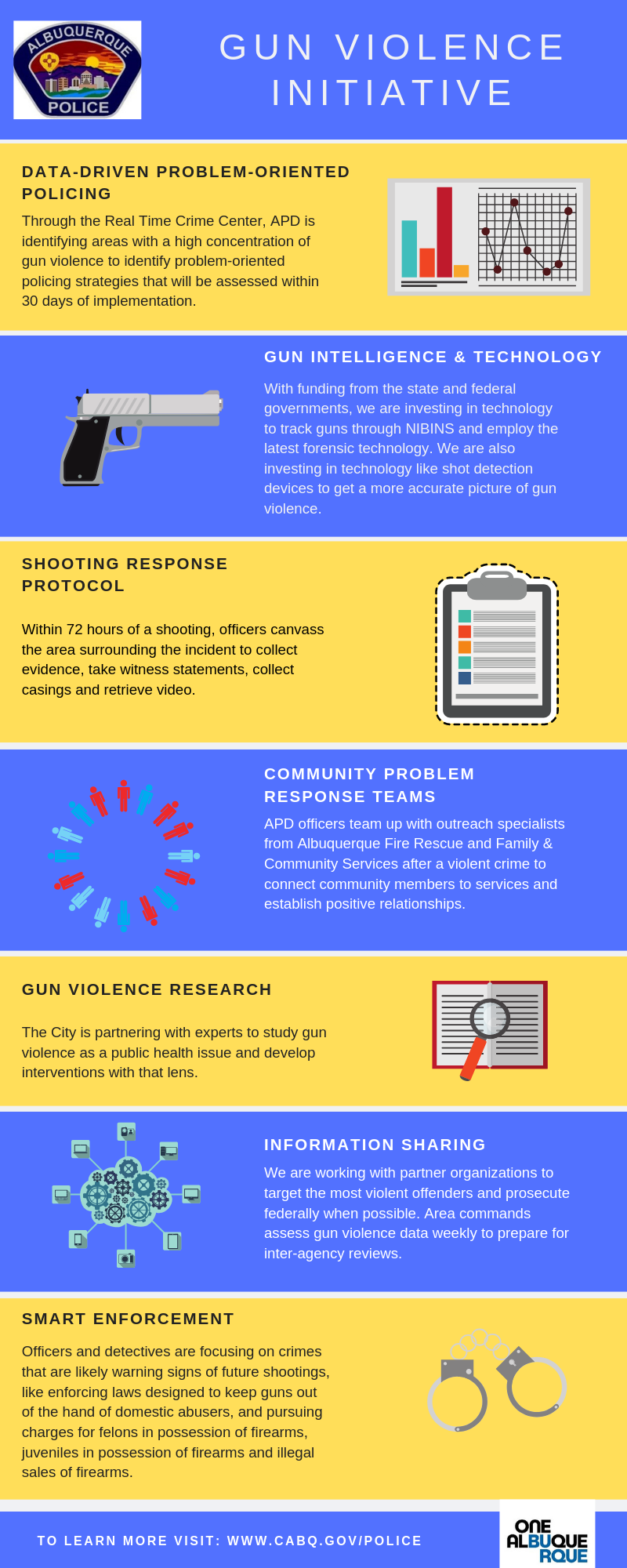
Mayor Keller, APD Outline Plan to Address Gun Violence
Multi-pronged plan addresses gun violence in Albuquerque.
April 8, 2019
Mayor Tim Keller and APD Chief Mike Geier held a news conference at the Crime Lab to outline a multi-pronged plan to address gun violence in Albuquerque.
“For nearly a decade, gun violence has become ever more pervasive and is often connected to other crimes,” Mayor Keller said. “We’ve heard the concerns from our communities and, today, we are rolling out a multi-pronged plan to tackle gun violence.
“We are combining community outreach with smart policing to keep neighborhoods safe. We are working with communities to identify problems and solve them with an emphasis on reducing gun violence.”
Chief Geier and his command staff outlined APD’s plan, which addresses gun violence through data-driven and problem-oriented policing, new technology to track gun violence, address community concerns, research the roots of gun crimes, and share information with other law enforcement agencies.
“We are taking proactive and reactive approaches in our plan to address gun violence in Albuquerque,” Chief Geier said. “The data is clearly showing where we need to focus our resources.”
PROACTIVE
Data-Driven POP Projects
- Work with RTCC to identify areas with heavy concentration of gun violence and design Problem-Oriented Policing projects to address crime
- 30-day assessment to study results and determine whether goals and objectives were attained
- Identify new strategies needed to augment original plan
Community Outreach: Problem Response Teams
- Leveraging APD’s Problem Response Teams to Support Community Engagement
- Learn from the community and address potential public safety shortcomings in the area.
- Continual outreach will be conducted by officers assigned to the Problem Response Team, along with Albuquerque Fire Rescue and Family and Community Services to communities affected by violence
- Establish relationships outside of the reaction to particular crimes
- Learn from the community and address potential public safety shortcomings in the area
Crime Stoppers – Additional focus on preventing gun violence
- Felon possessing a firearm
- Juvenile possessing a firearms
- Illegal sale of a firearm
Gun Violence Research
- Partner with health agencies and/or universities to study gun violence as a public health crisis
REACTIVE
Shooting Response Protocol
- 72-hour response
- Canvass within at least one block radius
- Collect evidence, intelligence, retrieve videos, identify potential witnesses or sources of information.
- Distribute community policing materials, including gun safety information
- Increase visibility
- Encourage better cooperation
- Help reduce the potential for retaliatory violence
Information Sharing
- Work with partner organizations to target most violent offenders and prosecute federally when possible
- Weekly Shooting activity assessment by Area Command
- Identify problems, develop mitigation strategies and continuous assessment
- Move additional resources to Area Command, if needed.
- Bi-weekly inter-agency shooting review
- Partner with DA and BCSO to review prior two week’s shooting incidents.
- Detectives/analysts will present case facts of the investigation, potential motives, contributing factors.
- Leverage information sharing, collaboration and sharing of resources, to identify trends of offenders frequently involved in gun violence.
Gun Intelligence Center/Crime Lab
- Gunshot detection technology
- Splitting of Human Identification Unit (DNA & Latents) to reduce backlog and lead to additional hits in CODIS and AFIS databases
- Latest Forensics technology
- Robotics to automate DNA processing
- Quicker results resulting in more CODIS hits
- Help obtain warrants and convictions of worse offenders
- Rapid DNA
- Improve AFIS data analytics
- Improve NIBIN acquisition process – currently takes 15 minutes per shell casing because of slow Wi-fi connection.
- Additional staff
- Interpret DNA results, leading to greater CODIS uploads
- Addition of 2 Latent Lab Techs will help reduce backlog of 539 items in evidence
- Re-tooled processes for firearms tagging, enhancing analysis of crime guns to include make/model/serial, recovery location, possessor information and ownership tracing via the ATF’s e-Trace system.
Violent Crime and Gang Reduction
- Gang Suppression Unit
- NIBIN ballistics tracking with increased capacity due to legislative funding
- Gun Violence Reduction Unit
- Work with District Attorney Task Force
- Work with federal partners to prosecute federally when possible.
- Work with DA’s Office to ensure the cases are properly prepared and prosecuted
- Work with DA’s Office on vertical prosecution.
- Work with RTCC to ID and address crime hot spots – violent crime, gang crime, narcotics crimes and property crimes.
- Gang detectives train field officers in intelligence collection and identification of gang members.
- APD Investigative Support Unit focus on repeat offenders
- Narcotics team
State Legislation
- Background Checks
- Domestic Violence – ban gun possession for people under permanent protective orders

